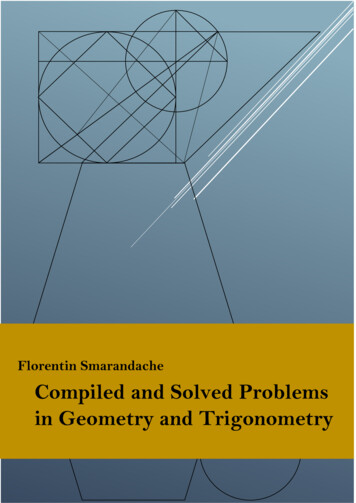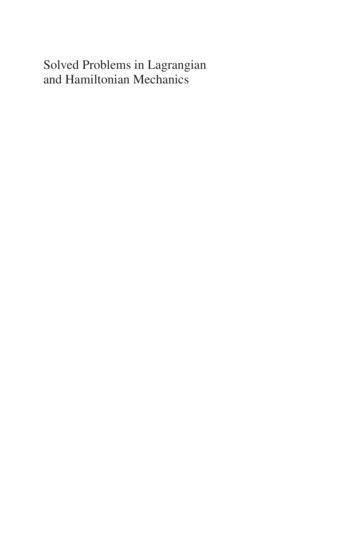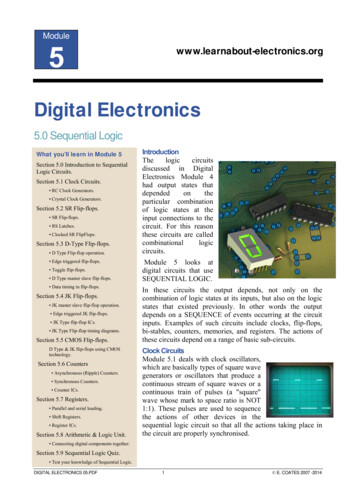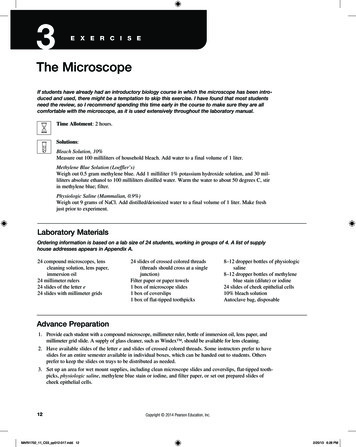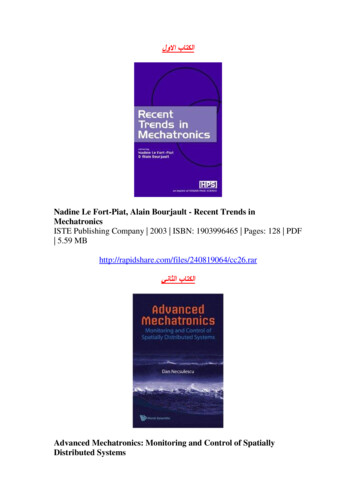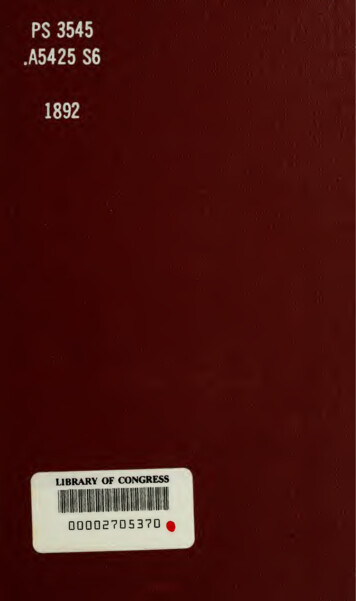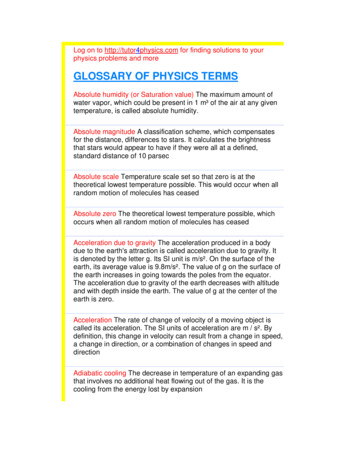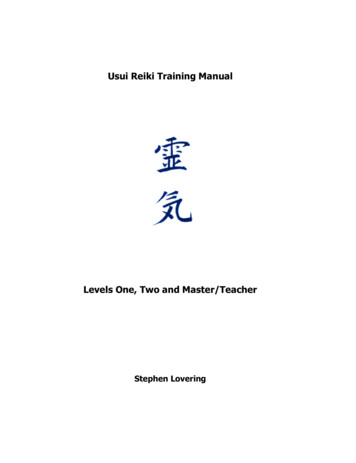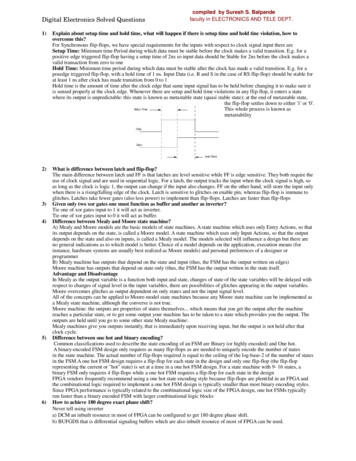
Transcription
Digital Electronics Solved Questionscompiled by Suresh S. Balpandefaculty in ELECTRONICS AND TELE DEPT.1)Explain about setup time and hold time, what will happen if there is setup time and hold tine violation, how toovercome this?For Synchronous flip-flops, we have special requirements for the inputs with respect to clock signal input there areSetup Time: Minimum time Period during which data must be stable before the clock makes a valid transition. E.g. for apositive edge triggered flip-flop having a setup time of 2ns so input data should be Stable for 2ns before the clock makes avalid transaction from zero to oneHold Time: Minimum time period during which data must be stable after the clock has made a valid transition. E.g. for aposedge triggered flip-flop, with a hold time of 1 ns. Input Data (i.e. R and S in the case of RS flip-flop) should be stable forat least 1 ns after clock has made transition from 0 to 1Hold time is the amount of time after the clock edge that same input signal has to be held before changing it to make sure itis sensed properly at the clock edge. Whenever there are setup and hold time violations in any flip-flop, it enters a statewhere its output is unpredictable: this state is known as metastable state (quasi stable state); at the end of metastable state,the flip-flop settles down to either '1' or '0'.This whole process is known asmetastability2)What is difference between latch and flip-flop?The main difference between latch and FF is that latches are level sensitive while FF is edge sensitive. They both require theuse of clock signal and are used in sequential logic. For a latch, the output tracks the input when the clock signal is high, soas long as the clock is logic 1, the output can change if the input also changes. FF on the other hand, will store the input onlywhen there is a rising/falling edge of the clock. Latch is sensitive to glitches on enable pin, whereas flip-flop is immune toglitches. Latches take fewer gates (also less power) to implement than flip-flops. Latches are faster than flip-flopsGiven only two xor gates one must function as buffer and another as inverter?Tie one of xor gates input to 1 it will act as inverter.Tie one of xor gates input to 0 it will act as buffer.Difference between Mealy and Moore state machine?A) Mealy and Moore models are the basic models of state machines. A state machine which uses only Entry Actions, so thatits output depends on the state, is called a Moore model. A state machine which uses only Input Actions, so that the outputdepends on the state and also on inputs, is called a Mealy model. The models selected will influence a design but there areno general indications as to which model is better. Choice of a model depends on the application, execution means (forinstance, hardware systems are usually best realized as Moore models) and personal preferences of a designer orprogrammerB) Mealy machine has outputs that depend on the state and input (thus, the FSM has the output written on edges)Moore machine has outputs that depend on state only (thus, the FSM has the output written in the state itself.Advantage and DisadvantageIn Mealy as the output variable is a function both input and state, changes of state of the state variables will be delayed withrespect to changes of signal level in the input variables, there are possibilities of glitches appearing in the output variables.Moore overcomes glitches as output dependent on only states and not the input signal level.All of the concepts can be applied to Moore-model state machines because any Moore state machine can be implemented asa Mealy state machine, although the converse is not true.Moore machine: the outputs are properties of states themselves. which means that you get the output after the machinereaches a particular state, or to get some output your machine has to be taken to a state which provides you the output. Theoutputs are held until you go to some other state Mealy machine:Mealy machines give you outputs instantly, that is immediately upon receiving input, but the output is not held after thatclock cycle.Difference between one hot and binary encoding?Common classifications used to describe the state encoding of an FSM are Binary (or highly encoded) and One hot.A binary-encoded FSM design only requires as many flip-flops as are needed to uniquely encode the number of statesin the state machine. The actual number of flip-flops required is equal to the ceiling of the log-base-2 of the number of statesin the FSM.A one hot FSM design requires a flip-flop for each state in the design and only one flip-flop (the flip-floprepresenting the current or "hot" state) is set at a time in a one hot FSM design. For a state machine with 9- 16 states, abinary FSM only requires 4 flip-flops while a one hot FSM requires a flip-flop for each state in the designFPGA vendors frequently recommend using a one hot state encoding style because flip-flops are plentiful in an FPGA andthe combinational logic required to implement a one hot FSM design is typically smaller than most binary encoding styles.Since FPGA performance is typically related to the combinational logic size of the FPGA design, one hot FSMs typicallyrun faster than a binary encoded FSM with larger combinational logic blocksHow to achieve 180 degree exact phase shift?Never tell using invertera) DCM an inbuilt resource in most of FPGA can be configured to get 180 degree phase shift.b) BUFGDS that is differential signaling buffers which are also inbuilt resource of most of FPGA can be used.3)4)5)6)
Digital Electronics Solved )22)compiled by Suresh S. Balpandefaculty in ELECTRONICS AND TELE DEPT.What is significance of RAS and CAS in SDRAM?SDRAM receives its address command in two address words. It uses a multiplex scheme to save input pins. The first addressword is latched into the DRAM chip with the row address strobe (RAS).Following the RAS command is the column address strobe (CAS) for latching the second address word.Shortly after the RAS and CAS strobes, the stored data is valid for reading.Tell some of applications of buffer?a) They are used to introduce small delays.b) They are used to eliminate cross talk caused due to inter electrode capacitance due to close routing.c) They are used to support high fan-out, e.g.: bufgGive two ways of converting a two input NAND gate to an inverter?a) Short the 2 inputs of the nand gate and apply the single input to it.b) Connect the output to one of the input and the other to the input signal.Why is most interrupts active low?This answers why most signals are active lowif you consider the transistor level of a module, active low means the capacitor in the output terminal gets charged ordischarged based on low to high and high to low transition respectively. When it goes from high to low it depends on thepull down resistor that pulls it down and it is relatively easy for the output capacitance to discharge rather than charging.Hence people prefer using active low signals.Design a four-input NAND gate using only two-input NAND gates.Basically, you can tie the inputs of a NAND gate together to get an inverter.What will happen if contents of register are shifter left, right?It is well known that in left shift all bits will be shifted left and LSB will be appended with 0 and in right shift all bits will beshifted right and MSB will be appended with 0 this is a straightforward answerWhat is expected is in a left shift value gets Multiplied by 2 e.g.: consider 0000 1110 14 a left shift will make it0001 110 28, it the same fashion right shift will Divide the value by 2.Given the following FIFO and rules, how deep does the FIFO need to be to prevent underflow or overflow?RULES:1) frequency(clk A) frequency(clk B) / 42) period(en B) period(clk A) * 1003) duty cycle(en B) 25%Assume clk B 100MHz (10ns)From (1), clk A 25MHz (40ns)From (2), period(en B) 40ns * 400 4000ns, but we only output for1000ns,due to (3), so 3000ns of the enable we are doing no output work. Therefore, FIFO size 3000ns/40ns 75 entriesDifferences between D-Latch and D flip-flop?D-latch is level sensitive where as flip-flop is edge sensitive. Flip-flops are made up of latches.What is a multiplexer?Is a combinational circuit that selects binary information from one of many input lines and directs it to a single output line.(2n n). Where n is selection line.What are set up time & hold time constraints? What do they signify? Which one is critical for estimating maximumclock frequency of a circuit?Set up time is the amount of time the data should be stable before the application of the clock signal, where as the hold timeis the amount of time the data should be stable after the application of the clock. Setup time signifies maximum delayconstraints; hold time is for minimum delay constraints. Setup time is critical for establishing the maximum clock frequency.How can you convert an SR Flip-flop to a JK Flip-flop?By giving the feedback we can convert, i.e. !Q S and Q R.Hence the S and R inputs will act as J and K respectively.How can you convert the JK Flip-flop to a D Flip-flop?By connecting the J input to the K through the inverter.How do you detect if two 8-bit signals are same?XOR each bits of A with B (for e.g. A [0] xor B [0]) and so on. The o/p of 8 xor gates is then given as i/p to an 8-i/p nor gate.if o/p is 1 then A B.Convert D-FF into divide by 2. (not latch) What is the max clock frequency the circuit can handle, given the followinginformation?T setup 6nsT hold 2nS T propagation 10nSCircuit: Connect Qbar to D and apply the clk at clk of DFF and take the O/P at Q. It gives freq/2. Max. Freq of operation: 1/(propagation delay setup time) 1/16ns 62.5 MHz7 bit ring counter's initial state is 0100010. After how many clock cycles will it return to the initial state?6 cyclesDesign all the gates (NOT, AND, OR, NAND, NOR, XOR, XNOR) using 2:1 Multiplexer?Using 2:1 Mux, (2 inputs, 1 output and a select line)a) NOT :Give the input at the select line and connect I0 to 1 & I1 to 0. So if A is 1, we will get I1 that is 0 at the O/P.b) AND: Give input A at the select line and 0 to I0 and B to I1. O/p is A & Bc) OR: Give input A at the select line and 1 to I1 and B to I0. O/p will be A Bd) NAND: AND NOT implementations togethere) NOR: OR NOT implementations togetherf) XOR: A at the select line B at I0 and B at I1. B can be obtained from (a)g) XNOR: A at the select line B at I1 and B at I0
Digital Electronics Solved Questionscompiled by Suresh S. Balpandefaculty in ELECTRONICS AND TELE DEPT.23) Design a circuit that calculates the square of a number?It should not use any multiplier circuits. It should use Multiplexers and other logic?1 2 0 1 12 2 1 3 43 2 4 5 94 2 9 7 165 2 16 9 25See a pattern yet? To get the next square, all you have to do is add the next odd number to the previous square that youfound. See how 1,3,5,7 and finally 9 are added. Wouldn’t this be a possible solution to your question since it only will use acounter, multiplexer and a couple of adders? It seems it would take n clock cycles to calculate square of n.24) N number of XNOR gates is connected in series such that the N inputs (A0, A1, A2.) are given in the followingway: A0 & A1 to first XNOR gate and A2 & O/P of First XNOR to second XNOR gate and so on. Nth XNOR gatesoutput is final output. How does this circuit work? Explain in detail?If N Odd, the circuit acts as even parity detector, i.e. the output will 1 if there are even number of 1's in the N input.Thiscould also be called as odd parity generator since with this additional 1 as output the total number of 1's will be ODD. IfN Even, just the opposite, it will be Odd parity detector or Even Parity Generator.25) What is Race-around problem? How can you rectify it?The clock pulse that remains in the 1 state while both J and K are equal to 1 will cause the output to complement again andrepeat complementing until the pulse goes back to 0, this is called the race around problem. To avoid this undesirableoperation, the clock pulse must have a time duration that is shorter than the propagation delay time of the F-F, this isrestrictive so the alternative is master-slave or edge-triggered construction.26) An assembly line has 3 fail safe sensors and one emergency shutdown switch. The line should keep moving unless anyof the following conditions arise:(i) If the emergency switch is pressed(ii) If the senor1 and sensor2 are activated at the same time.(iii) If sensor 2 and sensor3 are activated at the same time.(iv) If all the sensors are activated at the same timesuppose a combinational circuit for above case is to be implemented only with NAND Gates. How many minimum numberof 2 input NAND gates are required?No of 2-input NAND Gates required 6 you can try the whole implementation.27) How will you implement a Full subtractor from a Full adder?All the bits of subtrahend should be connected to the xor gate. Other input to the xor being one. The input carry bit to the fulladder should be made 1. Then the full adder works like a full subtract28) What is difference between setup and hold time. The interviewer was looking for one specific reason, and its really agood answer too.The hint is hold time doesn't depend on clock, why is it so.?Setup violations are related to two edges of clock, i mean you can vary the clock frequency to correct setup violation. Butfor hold time, you are only concerned with one edge and do not basically depend on clock frequency.29) In a 3-bit Johnson's counter what are the unused states?2(power n)-2n is the one used to find the unused states in Johnson counter.So for a 3-bit counter it is 8-6 2.Unused states 2. the two unused states are 010 and 10130) What is difference between RAM and FIFO?FIFO does not have address linesRam is used for storage purpose where as FIFO is used for synchronization purpose i.e. when
Digital Electronics Solved Questions 1) Explain about setup time and hold time, what will happen if there is setup time and hold tine violation, how to overcome this? For Synchronous flip-flops, we have special requirements for the inputs with respect to clock signal input there are


